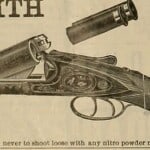
M1884 Rifle: A Glimpse into Late 19th Century Military Innovation
The Jarmann M1884 rifle, named after its creator Jacob Smith Jarmann, holds a significant position in the historical timeline of firearms development. With its unique design and functionality, it became one of the standout weapons in the late 19th century and set a standard for subsequent bolt-action rifles.
The Predecessors
The development of the Jarmann M1884 cannot be fully appreciated without discussing its predecessors. Jacob Smith Jarmann initially began designing firearms in the 1850s. His first significant design was a breech-loading rifle adopted by the Norwegian and Swedish army, the kammerlader, in 1860. While the kammerlader offered several improvements over the then-used muzzle-loading rifles, it still operated with a percussion cap, a technology which was becoming increasingly outdated due to the advent of metallic cartridges.
The development of metallic cartridges brought a revolution in firearms technology and inspired Jarmann to create a new rifle design that could accommodate this innovative ammunition. Thus, the concept of the Jarmann rifle was born.
Development and Manufacture
The Jarmann M1884 rifle was a single-shot, bolt-action, centerfire rifle, which marked a significant advance in firearm technology. It was one of the first service rifles to use a bolt-action mechanism that was designed for metallic cartridges. This change allowed for a quicker reloading time compared to its predecessors and provided a distinct advantage on the battlefield.
Jarmann submitted his design to the Swedish-Norwegian Rifle Commission in 1878. After extensive testing and minor modifications, the Commission approved the design for production in 1884. Thus, the Jarmann M1884 rifle entered into service.
The production of the Jarmann M1884 was handled primarily by two companies, Kongsberg Våpenfabrikk in Norway and Carl Gustafs Stads Gevärsfaktori in Sweden. Both had a long history of weapons manufacturing and were well equipped for mass production.
Kongsberg Våpenfabrikk had been in operation since 1814 and had been a key supplier of arms to the Norwegian military. Carl Gustafs Stads Gevärsfaktori, on the other hand, was established in 1812 in Eskilstuna, Sweden, and had been producing firearms for the Swedish military for several decades.
Between 1884 and 1886, these factories produced around 30,000 units of the Jarmann M1884 for the Norwegian army. Additionally, the rifle was adopted by the Swedish navy, though in fewer numbers.
Use and Impact
The Jarmann M1884 rifle had a short but impactful service history. It was used extensively by the Norwegian army in the 1880s and early 1890s. It was also employed by the Swedish navy during the same period.
The Jarmann M1884 was not used by the United States, but its influence extended beyond its primary users. The design's success triggered a shift in the global approach to military rifle development. Other countries, including Germany and Britain, soon adopted bolt-action rifles for their military forces.
Cartridges and Performance
The Jarmann M1884 was chambered for the 10.15×61mmR cartridge. The ammunition was a rimmed, black powder cartridge that was common among Scandinavian countries at the time. The cartridge featured a 400-grain bullet that traveled at approximately 1476 feet per second. This velocity, combined with the rifle's effective range of around 600 yards, made it a formidable weapon on the battlefield.
However, the transition from black powder to smokeless powder near the end of the 19th century led to the obsolescence of the Jarmann M1884. The rifle was not designed to handle the higher pressures produced by smokeless powder, which led to its gradual replacement.
Comparisons with Other Battle Rifles
The late 19th century was a time of rapid development in military firearms, and the Jarmann M1884 was not without competition. At the same time that the Jarmann was being introduced, the United States was adopting the Springfield Model 1884, a trapdoor rifle that also used black powder cartridges.
On the other side of the Atlantic, the British military was transitioning to the Lee-Metford rifle, a bolt-action rifle that utilized a magazine for faster reloading. Germany, too, was in the process of adopting the Gewehr 1888, a bolt-action rifle that was one of the first to use smokeless powder cartridges.
While these rifles represented the next generation of military firearms, the Jarmann M1884 held its own. Its single-shot, bolt-action design was simpler and less prone to jamming than magazine-fed rifles, and its robust construction meant that it was able to withstand the rigors of military use.
Conclusion
In conclusion, the Jarmann M1884 rifle represents an important milestone in the development of military firearms. Although its service life was relatively short, its innovative design set the stage for the next generation of bolt-action rifles. As one of the first service rifles designed for metallic cartridges, the Jarmann M1884 played a significant role in the evolution of firearms technology and remains an important piece of military history.
We know of no forums dedicated to this weapon, but there are a few YouTube videos including this one here.
If you know of any forums or sites that should be referenced on this listing, please let us know here.



